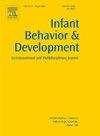莫桑比克城市和农村地区 13 个月大婴儿的注意敏感交流:接受者的行为和生活方式的影响
IF 2
3区 心理学
Q3 PSYCHOLOGY, DEVELOPMENTAL
引用次数: 0
摘要
最近的一些比较研究表明,婴儿早期的语用技能,如注意敏感交际(attention-sensitive communication, ASC),即根据接受者的注意调整交际信号的感觉模式的能力,受到接受者的行为和注意状态的影响。然而,尚未在非西方生态文化环境中进行研究,包括几个主要的照顾者。本研究旨在通过在莫桑比克农村和城市社区的家中拍摄13个月大的莫桑比克婴儿的ASC来弥合这一差距。ASC通过婴儿避免向视觉不集中的接受者发出无声视觉信号(单模态调整)和/或在这种情况下使用触觉或听觉信号(跨模态调整)的能力来评估。使用行为学定量编码的行为来测试(1)13个月大的婴儿是否表现出ASC,(2)生态文化环境影响ASC能力,(3)婴儿对母亲或非母亲接受者的称谓不同,以及(4)ASC对随后的语言技能具有预测价值。来自农村和城市社区的婴儿通过单模态和跨模态调整对母亲和非母亲接受者表现出ASC。母亲的婴儿指向语(IDS)和身体接触以及非母亲接受者的身体接触促进了婴儿的单峰适应。通过取消母亲的身体接触和取消非母亲接受者的IDS,减轻了跨模态调整。跨模态调整能力预测了MBCDI中较高的词汇生成得分。这些研究结果表明,非西方国家婴儿的发育过程中存在ASC,并以接受者的行为为基础,这些行为因接受者的地位和生态文化环境而异。本文章由计算机程序翻译,如有差异,请以英文原文为准。
Attention-sensitive communication in 13-month-old infants from urban and rural areas in Mozambique: Influence of the recipient’s behaviour and lifestyle
A handful of recent comparative studies indicates that infants’ early pragmatic skills such as attention-sensitive communication (ASC), i.e., the ability to adjust the sensory modality of communicative signals to the recipient’s attention, are affected by the recipient’s behaviour and attentional state. However, no study has been conducted in non-western eco-cultural environments comprising several main caregivers. This study aimed to bridge this gap by examining ASC in 13-month-old Mozambican infants filmed in their homes in rural and urban communities in Mozambique. ASC was assessed through infants’ ability to avoid producing a silent-visual signal towards a visually inattentive recipient (unimodal adjustment) and/or instead employ tactile-or-audible signals in such situations (cross-modal adjustment). An ethological quantitative coding of behaviour was used to test if (1) 13-month-old infants displayed ASC, (2) eco-cultural environments affected ASC abilities, (3) infants addressed their mother or a non-maternal recipient differently, and (4) ASC was of predictive value regarding subsequent language skills. Infants from both rural and urban communities displayed ASC through unimodal and cross-modal adjustments, towards their mother and non-maternal recipients. Infants’ unimodal adjustment was facilitated by the mother’s Infant-Directed Speech (IDS) and physical contact and by non-maternal recipients’ physical contact. Cross-modal adjustment was eased by the removal of the mother’s physical contact and by the removal of non-maternal recipients’ IDS. Cross-modal adjustment abilities predicted a higher vocabulary production score in the MBCDI. These findings indicate that ASC is present in non-western infant development and is scaffolded on recipients’ behaviours, which vary according to the recipient’s status and eco-cultural environment.
求助全文
通过发布文献求助,成功后即可免费获取论文全文。
去求助
来源期刊

Infant Behavior & Development
PSYCHOLOGY, DEVELOPMENTAL-
CiteScore
4.10
自引率
4.80%
发文量
94
期刊介绍:
Infant Behavior & Development publishes empirical (fundamental and clinical), theoretical, methodological and review papers. Brief reports dealing with behavioral development during infancy (up to 3 years) will also be considered. Papers of an inter- and multidisciplinary nature, for example neuroscience, non-linear dynamics and modelling approaches, are particularly encouraged. Areas covered by the journal include cognitive development, emotional development, perception, perception-action coupling, motor development and socialisation.
 求助内容:
求助内容: 应助结果提醒方式:
应助结果提醒方式:


